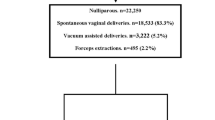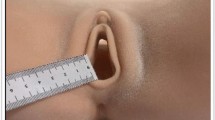Abstract
Introduction and hypothesis
The objective of this study was to investigate the association between the trigonometric properties of episiotomy in operative vaginal delivery (OVD) and obstetric anal sphincter injuries (OASIS).
Methods
The study included 72 primiparous women who had an OVD and episiotomy. Cases (n = 36) had sustained OASIS at birth, while controls (n = 36) had not. The groups were matched for instrumental delivery. The episiotomy scar was identified and its trigonometric characteristics were measured at 8–12 weeks postpartum. Data were analysed using conditional logistic analysis.
Results
The angle of episiotomy behaves as a factor associated with anal sphincter injury, so women with a mediolateral episiotomy and an angle greater than 20° have an 87 % less risk of having an OASIS (odds ratio 0.13, 95 % confidence interval 0.03–0.58). The study showed that scarred episiotomies at 8–12 weeks after OVD with an angle ≤ 20°, depth and distance between the episiotomy and anus ≤ 15 mm, total upper triangle perimeter ≤ 75 mm, para-anal triangle perimeter ≤ 15 mm and areas between scar and midline ≤ 250 mm2 were significantly associated with higher risk of OASIS.
Conclusions
When a mediolateral episiotomy is performed in OVD the technique has a strong effect on the occurrence of OASIS. Additional research is needed to determine if the optimal technique for mediolateral episiotomies produces less OASIS than deferring the performance of episiotomy.



Similar content being viewed by others
References
Weber A (2004) The perspective of a gynecologist on treatment-related research for fecal incontinence in women. Gastroenterology 126:S169–S171
de Leeuw JW, Struijk PC, Vierhout ME, Wallenburg HC (2001) Risk factors for third degree perineal ruptures during delivery. BJOG 108:383–387
Christianson LM, Bovbjerg VE, McDavitt EC, Hullfish KL (2003) Risk factors for perineal injury during delivery. Am J Obstet Gynecol 189:255–260
Dandolu V, Chatwani A, Harmanli O, Floro C, Gaughan JP, Hernandez E (2005) Risk factors for obstetrical anal sphincter lacerations. Int Urogynecol J Pelvic Floor Dysfunct 16:304–307
Robinson JN, Norwitz ER, Cohen AP, McElrath TF, Lieberman ES (1999) Episiotomy, operative vaginal delivery, and significant perinatal trauma in nulliparous women. Am J Obstet Gynecol 181(5 Pt 1):1180–1184
Kudish B, Blackwell S, Mcneeley SG et al (2006) Operative vaginal delivery and midline episiotomy: a bad combination for the perineum. Am J Obstet Gynecol 195(3):749–754
Youssef R, Ramalingam U, Macleod M, Murphy DJ (2005) Cohort study of maternal and neonatal morbidity in relation to use of episiotomy at instrumental vaginal delivery. BJOG 112(7):941–945
Hudelist G, Gelle’n J, Singer C et al (2005) Factors predicting severe perineal trauma during childbirth: role of forceps delivery routinely combined with mediolateral episiotomy. Am J Obstet Gynecol 192(3):875–881
Tayrac R, Panel L, Masson G, Mares P (2006) Episiotomy and prevention of perineal and pelvic floor injuries. J Gynecol Obstet Biol Reprod (Paris) 35(1 Suppl):1S24–1S31
de Vogel J, van der Leeuw-van Beek A, Gietelink D et al (2012) The effect of a mediolateral episiotomy during operative vaginal delivery on the risk of developing obstetrical anal sphincter injuries. Am J Obstet Gynecol 206:404.e1–404.e5
Räisänen S, Vehviläinen-Julkunen K, Cartwright R, Gissler M, Heinonen S (2012) Vacuum-assisted deliveries and the risk of obstetric anal sphincter injuries—a retrospective register-based study in Finland. BJOG 119:1370–1378
Combs CA, Robertson PA, Laros RK Jr (1990) Risk factors for third-degree and fourth-degree perineal lacerations in forceps and vacuum deliveries. Am J Obstet Gynecol 163(1 Pt 1):100–104
de Leeuw JW, de Wit C, Kuijken JP, Bruinse HW (2008) Mediolateral episiotomy reduces the risk for anal sphincter injury during operative vaginal delivery. BJOG 115(1):104–108
Murphy D, Macleod M, Bahl R, Goyder K, Howarth L, Strachan B (2008) A randomised controlled trial of routine versus restrictive use of episiotomy at operative vaginal delivery: a multicentre pilot study. BJOG 115:1695–1703
Macleod M, Goyder K, Howarth L, Bahl R, Strachan B, Murphy D (2013) Morbidity experienced by women before and after operative vaginal delivery: prospective cohort study nested within a two-centre randomised controlled trial of restrictive versus routine use of episiotomy. BJOG 120:1020–1027
Kalis V, Stepan J Jr, Horak M, Roztocil A, Kralickova M, Rokyta Z (2008) Definitions of mediolateral episiotomy in Europe. Int J Gynaecol Obstet 100:188–189
Tincello DG, Williams A, Fowler GE, Adams EJ, Richmond DH, Alfirevic Z (2003) Differences in episiotomy technique between midwives and doctors. BJOG 110:1041–1044
Andrews V, Thakar R, Sultan AH, Jones PW (2005) Are mediolateral episiotomies actually mediolateral? BJOG 112:1156–1158
van Dillen J, Spaans M, van Keijsteren W et al (2010) A prospective multicenter audit of labor-room episiotomy and anal sphincter injury assessment in the Netherlands. Int J Gynaecol Obstet 108:97–100
Hartmann K, Viswanathan M, Palmieri R, Gartlehner G, Thorp J Jr, Lohr KN (2005) Outcomes of routine episiotomy: a systematic review. JAMA 293:2141–2148
Eogan M, Daly L, O’Connell PR, O’Herlihy C (2006) Does the angle of episiotomy affect the incidence of anal sphincter injury? BJOG 113:190–194
Andrews V, Sultan AH, Thakar R, Jones PW (2006) Risk factors for obstetric anal sphincter injury: a prospective study. Birth 33:117–122
Kalis V, Landsmanova J, Bednarova B, Karbanova J, Laine K, Rokyta Z (2011) Evaluation of the incision angle of mediolateral episiotomy at 60 degrees. Int J Gynaecol Obstet 112:220–224
Stedenfeldt M, Pirhonen J, Blix E, Wilsgaard T, Vonen B, Øian P (2012) Episiotomy characteristics and risks for obstetric anal sphincter injuries: a case–control study. BJOG 119:724–730
Fernandez Galguera MJ, Gonzalez Diaz E, Padilla Mozo L, Fernandez Fernandez C, Fernandez Corona A (2013) Lesiones perineales durante el parto vaginal. Poster XXXII Congreso Nacional SEGO. doi: 10.4395/Pulso.ed.Cong.SEGO.2013.Poster.N736
Drife J (1996) Choice and instrumental delivery. Br J Obstet Gynaecol 103:608–611
Geller EJ, Robinson BL, Matthews CA et al (2014) Perineal body length as a risk for ultrasound-diagnosed anal sphincter tear at first delivery. Int Urogynecol J 25:631–636
Kalis V, Chaloupka P, Turek J, Rokyta Z (2005) The perineal body length and injury at delivery. Ceska Gynekol 70(5):355–361
Kalis V, Karbanova J, Horak M, Lobovsky L, Kralickova M, Rokyta Z (2008) The incision angle of mediolateral episiotomy before delivery and after repair. Int J Gynaecol Obstet 103:5–8
Conflicts of interest
None.
Author information
Authors and Affiliations
Corresponding author
Rights and permissions
About this article
Cite this article
Gonzalez-Díaz, E., Moreno Cea, L. & Fernández Corona, A. Trigonometric characteristics of episiotomy and risks for obstetric anal sphincter injuries in operative vaginal delivery. Int Urogynecol J 26, 235–242 (2015). https://doi.org/10.1007/s00192-014-2491-x
Received:
Accepted:
Published:
Issue Date:
DOI: https://doi.org/10.1007/s00192-014-2491-x




